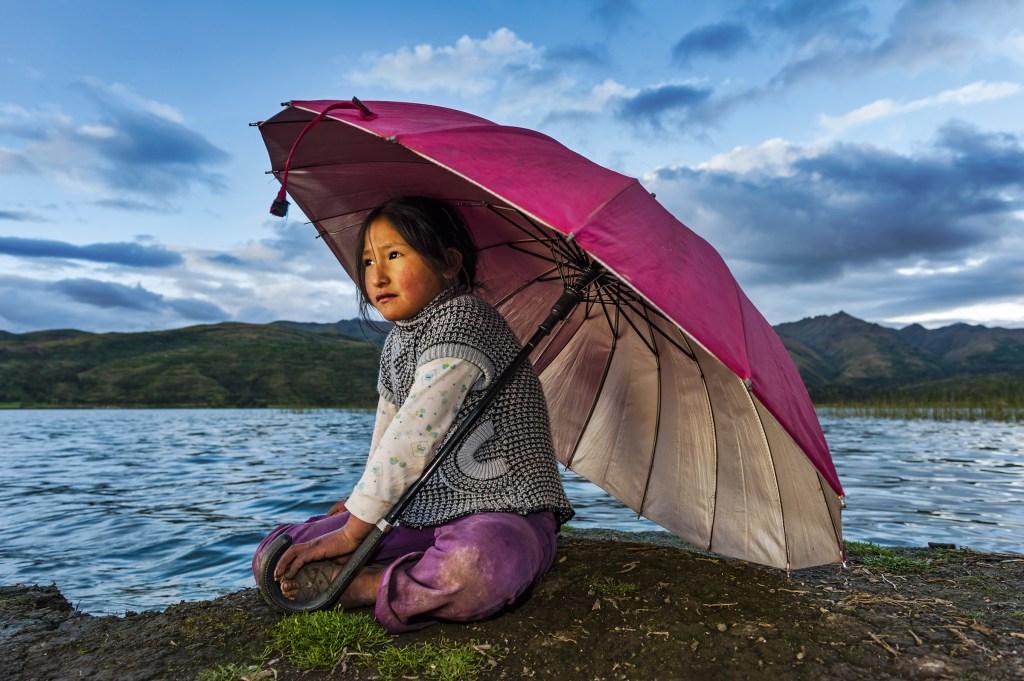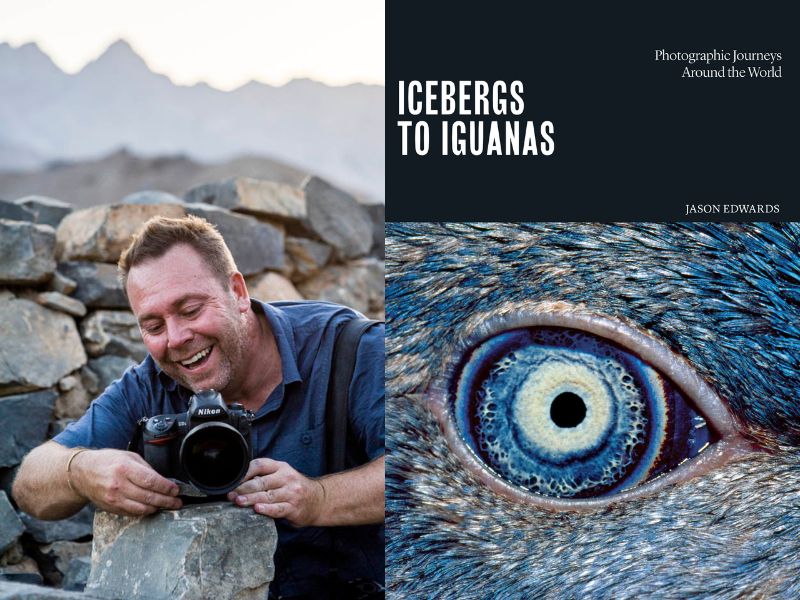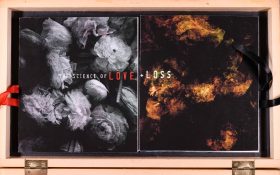Icebergs to Iguanas: Photographic Journeys Around the World is a love letter to planet Earth, a gift by Jason Edwards, long-time photographer for National Geographic. He is in fact the only Australian National Geographic photographer, and this is his first book.
The 400-page text offers a rare insight into regions and communities across the globe that most of us will never visit. Interspersed with emotive little asides from Edwards’ field journals, the book is humming with beauty and vast landscapes, as well as moments of horror, survival and perseverance.
Edwards is an award-winning photographer and conservationist who has been photographing the natural world and human societies for over 30 years. Icebergs to Iguanas is a carefully curated offering of his photos, personal experiences and stories gathered along the way, divided into eight specific topics that have captured his imagination and his lens over the past three decades. In a world where most species, countries and peoples seem to have been documented, Edwards still manages to surprise, providing new ways of seeing and understanding the familiar.
He shines a light on the shipbreakers of India, risking life and limb as he enters the dark hulls of huge ships that are sliced up around him, with massive hunks of steel falling to the ground nearby. He takes us into the ‘Festival of the Tooth’ in Sri Lanka, where endangered elephants are venerated, covered in silk and lights, and celebrated in an annual festival.
He explores the relationship between wild brumbies and First Nations teenagers in Arrernte Country, carefully navigating his own concerns about the ecological impact of the horses with his love for the young people he meets and gets to know. In ‘The Spine of the World’, we traverse the longest mountain range, from the northern tip of the Andes in Peru down to Antarctica, in a detailed exploration of the west coast of South America and the world’s coldest continent.

When Edwards ventures into the Amazon, it’s to explore its beauty and species as well as its viciousness and violence, including the horror of the illegal wildlife trade and the dangers he faced crossing multiple country borders and travelling on the world’s most famous river.
‘The Great Migration’ provides a new way of seeing Africa’s wildlife as Edwards highlights the drama surrounding the annual migration of ‘two million wildebeest and zebra and more than one million gazelle in a tide of flesh and horn, stalked by the predators that await the arrival of the rains and the calving season of the herbivores’.
After severe illness, Edwards found that he was most comfortable taking photos by leaning his head back, and so the ‘Ceilings of the Sky’ section was made possible: a cavalcade of glorious colours that are the ceilings of buildings and mosques built by the Persian Empire in Iran. The final chapter focuses on Edwards’ time with the Asmat tribe of Papua New Guinea, including ceremonies and cultural exchanges that few outside the communities have ever seen, finishing with an exquisite dive into the ‘pristine coral gardens… that have succumbed to the ravages of climate change’.
We read about how he was caught up in the momentum of a street parade in Sri Lanka, how he nearly died of multiple fevers and illnesses, and how a simple cut on the knee nearly led to a leg amputation. Edwards goes where many of us will not and cannot, and this beautiful book is our way of gaining a snippet of understanding of these worlds.
By including the stories of people, cultures and issues such as climate change and the illegal wildlife trade, Edwards has elevated this photography book into something more than just a catalogue of beauty, landscapes and species. His writing is as precise and eloquent as his images. In a journal entry in ‘The Great Migration’, he writes: ‘As I fell asleep a half moon rose above my toes. The lions called through the African night, and I was at peace.’
On a double-page with a vibrant purple, magenta and yellow sunset in the Andes, he says:
‘Sometimes nature’s light sings a ballad, at other times a rock song. Then there are moments when it’s floating through the gentle caress of an opera. Music, words, images, nothing will ever conquer the first metre of the majesty of the Andes. That is when you put the oar aside and let the current take you where it will.’
Jason Edwards
His sparkling prose and unflinching insight are peppered throughout, inviting us into some intimate, super-charged, dangerous, horrifying and magnificent moments in our world. Edwards doesn’t pull any punches in describing the illegal wildlife trade in the Amazon, what’s driving it (the international trade in cute exotic pets and traditional medicine) and the trauma the animals experience. He also doesn’t flinch from honest introspection about what it’s like to be a Westerner and an outsider, such as when photographing the shipbreakers in India and the Asmat tribe in Papua New Guinea.

Accompanying the stories are (as you’d expect) exquisite photographs, including quadruple page spreads such as the vast multicoloured African savannah; the turbulent sea of the Drake Passage where the Atlantic, Pacific and Southern Oceans connect; and the exquisite detail of the huge, layered ceiling in the Nasir ol Molk Mosque in Iran. The book is large, so the replicated images allow you to sink into the vast vistas, into the eyes of toucans or leopards, into the colours of ceremony in Sri Lanka or into the wildness of a Central Australian horse race in the red dust.
While Edwards’ stories and field journals provide meaning and structure to the images, it’s the photography that has pride of place. From the bark-like skin of an elephant to the intricate barbs on a parrot’s feather to soaring geometric ceilings that evoke eternity, Edwards’ photography will reward with multiple views. Each section has images that will feel familiar, including aerial shots of Machu Picchu, First Nations children in waterholes, a vulture’s beak red from its dinner of zebra, a penguin skating on white ice under a cobalt sky, and soaring Amazon trees that disappear at their tips, but there are also images that most of us will have never seen.
The grass spirit-masks of the Asmat tribe in Papua New Guinea as they ‘whip back and forth inciting the audience into a frenzy’. A weak, young sloth (who the sellers misnamed a ‘monkey’) being sold at a bushmeat market. The rusty hull of a massive ship looming over the men who will shoulder the burden of their job, risking death every day. A violent fight between two male brumbies over a waterhole, teeth bared and hooves kicking. The wild terrified eyes of a young, orphaned elephant being cared for at the Elephant Transit Home.
Read: Exhibition review: Yeahnahnesia, Art Gallery of Western Australia
To say this book is beautiful is to undersell its depth, its reach, its courage and its power. Mirroring our tumultuous world, Icebergs to Iguanas will challenge and change you, and it has it all: oceans, rivers, coral cliffs, mountaintops, lush rainforests, ancient traditions, human interactions with nature, endangered species, some of humanity’s greatest art and so many animals, insects, amphibians and birds.
Edwards is generous with his stories and his honest portrayal of his experiences, also sharing photography techniques and lessons for those who may want to try their hand at wildlife and conservation photography. It’s a life that’s not for the faint of heart, and he outlines throughout the book just what it takes to reach this level of expertise. For the vast majority of us, who will never tread where Edwards does, this book will open eyes and hearts.
Icebergs to Iguanas, Jason Edwards
Publisher: Jason Edwards Photography
ISBN: 9780648818502
Format: Hardback
Pages: 424pp
Publication Date: September 2022
RRP: $125





